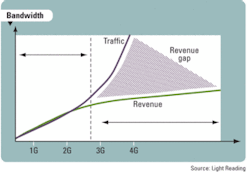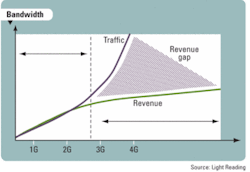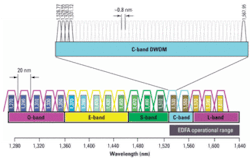Changing paradigms affect cellular networks
By Bart Filipiak
Overview
The advent of 3G and 4G services puts greater pressure than ever on all aspects of a cellular network. Advances in optical communications at the systems and cabling levels make fiber an even better choice for burgeoning backhaul requirements.
Alexander Graham Bell is credited with changing the way the world conducts business through his invention of the telephone back in the 1870s. Until then, the telegraph had been the central nervous system of corporations around the world, and operators like Western Union needed a way to leverage existing lines to transmit multiple streams of information. They figured this would be far cheaper than installing new telegraph lines, and they were right. The telephone improved corporate efficiency like no other device in history. It spurred a paradigm shift, not just for commercial entities but for the general public as well.
More than 100 years later, the telephone is still the dominant means of communication the world over. Yes, it is true that today’s telephones have little in common with the “Mr. Watson, come here... I need you” device in Bell’s lab, but the concept and underlying utility still ring true. In most places around the world today, it is unthinkable that an office or home could be without a telephone–and very often, that telephone is mobile. And as the services we expect that mobile phone to provide continue to multiply, so do the demands placed on the network that supports it.
How we got here
We can trace the birth of mobile telephones back to the early 1900s, but fully automated cellular telephone networks–what we now call 1G–were not deployed until the early to mid-1980s. Thanks to Mr. Bell and the American Telephone and Telegraph company, telephone cables were virtually everywhere in the United States, and that meant it would be relatively cheap and easy to use them to connect these cell towers to the rest of the public switched telephone network via DS-1 lines, also known as T1s. T1s are very reliable, full-duplex, 1.544-Mbps TDM circuits originally developed to transmit voice digitally. The T1 data stream comprises buckets that may or may not be used depending on whether or not that voice channel is being used.
In the early days, one or two T1 circuits were quite sufficient at the cell site. It was a nascent industry, and its few customers used the system sparingly. Furthermore, the wireless operator’s limiting and most crucial resource was analog RF spectrum for its voice calls.
In the mid- to late 1990s, this all started to change. Operators began to deploy digital 2G systems to replace the analog 1G system, and growth in wireless started to explode. Digital phones required far less battery power, making them much more portable. Call quality greatly improved, and voice was still the primary application.
However, the frequencies used also changed from the 800/900-MHz range up to the 1,800-MHz range. Spectral efficiency improved due to digital signaling between the handset and cell site, so RF spectrum was no longer a wireless operator’s chief concern. A more pressing issue was how far the signal propagated, or to be more accurate, how far it did not propagate. This change in frequency essentially cut the effective cell range by two-thirds, as radio-wave attenuation increases with frequency. Now the problem was providing coverage. You likely recall the marketing approaches of the time touting an operator’s nationwide coverage or call reliability.
The next major paradigm shift came in the early 2000s when carriers began to deploy 3G networks. This change focused not so much on how the cells worked but rather how consumers used wireless devices. Voice was still king, but we were also suddenly able to browse the Internet, send instant messages, and check e-mail on our portable wireless devices (no longer just a mere phone).
Wireless operators quickly learned that data usage on mobile devices represented a significant portion of their average revenue per user (ARPU). These data applications, such as web browsing and instant messaging, require more bandwidth than voice-only connections, but the bandwidth demand is very sporadic and certainly not as time-dependent as voice. Where a user would absolutely notice even a half-second delay while trying to hold a conversation, the same half-second delay is hardly noticed, if at all, while requesting a web site or sending an instant message.
Just as RF spectrum was a limiting factor in 1G, and coverage area was the limiting factor in 2G, backhaul capacity has now become the limiting factor for 3G and will be even more confining with the emerging 4G networks. The one or two T1s that easily provided sufficient bandwidth for voice-only applications can no longer keep up with the ever-increasing consumer demand for more bandwidth.
Tier 1 wireless operators are now beginning to deploy their 4G services, namely WiMAX and LTE. These technologies promise user speeds up to 100 Mbps in the downlink for a mobile user. How much backhaul is that going to require? Significantly more than a handful of T1s can provide. Clearly something must change. Enter packet-based backhaul.
Opening the bottleneck
Recall that T1s became the backhaul medium of choice in America due in large part to their ubiquity. Cable TV companies, also known as multiple system operators (MSOs), were deploying their own networks across the nation using a hybrid fiber/coax topology, just as wireless operators were building out their networks for a very different purpose. High-quality fiber-optic cable was relatively expensive at the time, so it was deployed in low counts and with limited reach. Fast-forward a few years, and now when a commercial entity requires broadband connectivity, it can call on two providers: the local exchange carrier (LEC) or the MSO.
It is no big secret that LECs have been deploying FTTX networks in their markets to offer triple-play packages to their residential customers. To keep up with this new competition, MSOs are also overhauling their networks to provide increased broadband capabilities. Where the LEC sees new opportunities for residential customers, the MSO sees new opportunities for commercial services. In many regards, a cell site is just another commercial customer but with very stringent latency and quality requirements.
As mentioned at the beginning of this article, the goal behind the development of the telephone was the further use of existing telegraph lines. MSOs are in a similar situation now, but there is a difference. The optical fiber capacity they deploy can be multiplied very simply by WDM. While the next great invention of our time may not be spurred by this technology, it enables service providers a means to further leverage their existing networks and save some money.
As cellular backhaul evolves, backhaul providers must plan to provide service to legacy 2G and 3G T1-native base transceiver stations and newer 4G Ethernet-native base transceiver stations at the same cell site. WDM, just like optical fiber, is protocol agnostic. It is every bit as compatible with SONET/SDH as it is with Ethernet.
Another benefit is gained through the use of upgrade ports. Upgrade ports enable a service provider to add channels as their needs grow, without taking down the network to perform the upgrade. Upgrade ports also provide the ability to overlay DWDM on a CWDM deployment. Notice in Fig. 2 that the most common DWDM range is the C-band. There are 50 DWDM channels available in the C-band. If an initial CWDM system is deployed, and C-band channels at 1,530 and 1,550 nm are skipped; this range may later be used to deploy approximately 36 DWDM channels. For full C-band DWDM use, you would also need to skip 1,510 nm and 1,570 nm due to the wide passband overlap into the C-band region.
Another way backhaul providers can save money is by taking advantage of recent preconnectorized and pre-spliced cable assemblies. These cable assemblies are custom built for each application and can be deployed in as little as half the time of traditional outside plant cable.
In many cases, a cable route is designed but cannot be installed until make-ready work has been completed along the route. This time is normally unused in as far as the actual cable plant is concerned. Once make-ready work is finished, the cable is installed, and a splicing crew follows the route and splices the cable according to the splice plan. By using pre-spliced and preconnectorized cable assemblies, service providers can now take advantage of that “downtime” by having the route prebuilt in a factory. Once the make-ready work is complete and the route is ready, the cable assembly is installed along the route as fast as the crew can overlash it. Once up, it is ready for use and can begin generating revenue almost immediately.
Another advantage of factory pre-spliced cable assemblies is that they remove variances common in outside plant cable installation such as splice loss due to environment, cross-splices, and environmental delays. All pre-spliced assemblies are spliced in ideal lab conditions and tested before leaving the manufacturer, removing unnecessary troubleshooting delays in the field. Hardened multifiber connectors are used at all network access points, and dust caps are installed to ensure these connectors remain clean until connection in the field (see Fig. 3). Once connected, they remain sealed against the elements and never require cleaning unless disconnected.
Pre-spliced cable assemblies are a recent addition to the outside plant installation toolbox and can save a backhaul provider precious time and money. Consider this new tool the next time you need to install some cable.
Alexander Graham Bell certainly had no idea how much our lives would intertwine with his invention and its distant wireless cousins. Home security systems, laptop computers, and even cars now come equipped with built-in devices that rely on our cellular phone system.
One thing we can be certain of is that cellular bandwidth demands will continue to grow exponentially, and infrastructure installed today must be able to economically scale accordingly. Fiber is certainly not the only option for cellular backhaul, but it does provide nearly limitless scalability, and factory-spliced cable assemblies make it more attractive than ever.
Bart Filipiakis a market development manager at Corning Cable Systems.
Lightwave:PONs Find Niche in Wireless Backhaul
Lightwave Online: China Mobile Deploys Alcatel-Lucent’s Packet-Optical Transport Technology
Lightwave Online: Infonetics: Mobile Backhaul Equipment Market to Skyrocket



